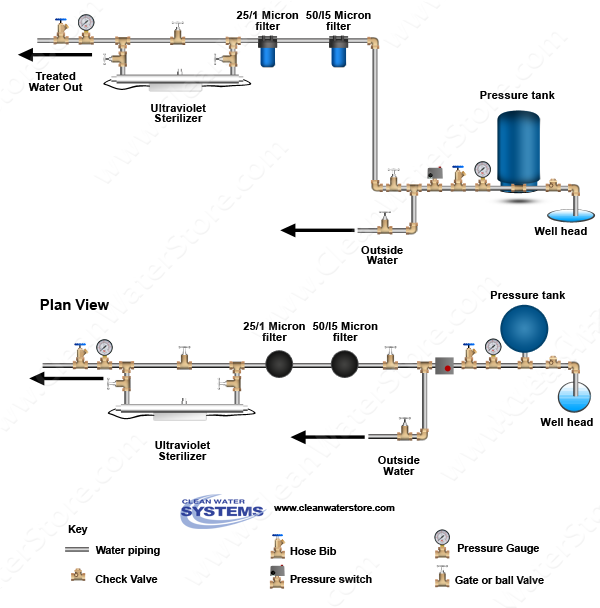Should I Install an Ultraviolet Light System Before or After a Water Softener?


UV Light Water Treatment: Should I Install an Ultraviolet Light System Before or After a Water Softener?
Adding a UV disinfection system is a powerful way to sterilize your water, but when should you install it? Here are a few simple guidelines to help you get the most out of your setup.
First, water treated by UV light should be clear and low in minerals. If the hardness exceeds 5–10 grains per gallon, use a water softener first.
If you have a water softener, install the UV sterilizer last, after the softener.


Typical UV System Setup
If the water is cloudy or high in turbidity, it must be treated first. UV light works best when the UV Transmission level (“UVT”) is high enough for the rays to penetrate. At minimum, use a 5-micron filter for pretreatment.
If the well is influenced by surface water, it may contain parasites like Giardia. In this case, use a 1-micron absolute filter before the UV sterilizer, or consider an ultra-filtration system.
Introduction to UV Water Treatment
UV water treatment systems are a popular choice for homes and businesses. They use ultraviolet light to neutralize harmful microorganisms, offering a chemical-free, eco-friendly alternative to traditional methods. By using UV systems, you can eliminate bacteria, viruses, and other pathogens, ensuring your drinking water stays safe and clean. This article explores how UV systems work, their effectiveness, and their safety features.
How UV Light Systems Work
UV light systems target and destroy harmful microorganisms like bacteria, viruses, and parasites. A UV lamp emits ultraviolet light, which passes through the water and disrupts the DNA of microorganisms. This prevents them from reproducing and causing illness. UV treatment offers high-level purification without chemicals or additives.
What is UV Water Treatment?
UV water treatment uses ultraviolet light to eliminate microorganisms in water. It is effective against bacteria, viruses, and parasites and offers a chemical-free, eco-friendly alternative to traditional disinfection methods. UV systems help ensure your water supply is safe, providing peace of mind and protecting your health.
Effectiveness and Safety of UV Systems
UV systems are highly effective against bacteria, viruses, and parasites. They are also safe because they produce no byproducts or waste. UV disinfection is a physical process that does not change the water's taste, odor, or chemical makeup. However, UV systems do not remove non-biological contaminants like heavy metals or chemicals. For full protection, UV treatment is often paired with other filtration methods, such as reverse osmosis systems.
Recent Posts
Water Quality for Horses and Livestock: A Guide to Healthier Barns and Pastures
Clean water is the cornerstone of animal health and productivity. Whether you're raising horses, cattle,…
Clean Drinking Water for Cats: What Every Cat Owner Should Know
Why Clean Drinking Water Matters for Cats Hydration is critical to a cat’s overall health,…
Pet Hydration: What to Know About Water Safety
Clean Drinking Water for Dogs: What Every Dog Owner Should Know Clean drinking water is…
How to Ensure Fresh, Safe Water for Your Birds: Daily Care Tips for Bird Owners
Why Filtered Water for Birds Is Essential for Their Health Like food, clean drinking water…
U.S. Water Problems by Region: Common Contaminants & Solutions
Curious about U.S. water problems by region? Water quality isn’t just a national issue—it’s a…
Wildfire Water Contamination: How to Ensure Safe Water After a Fire
Wildfire Water Contamination: What You Need to Know After the Fires Drinking water contamination is…


